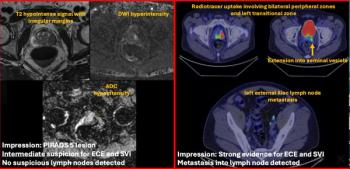
Incorrect breast positioning on mammography misses cancers
Equipment innovations need to be testedImproper breast positioning is responsible for more missed cancers than any other aspect of a mammography exam, according to a new study examining mammography performance in everyday practice.
Equipment innovations need to be tested
Improper breast positioning is responsible for more missed cancers than any other aspect of a mammography exam, according to a new study examining mammography performance in everyday practice.
More cancers are overlooked during standard mammographic screening if the pectoralis muscle is hidden from full view, the nipple is not profiled, or if the amount of scanned tissue is inadequate, according to Dr. Stephen Taplin, senior investigator for Center Health Studies at the Group Health Cooperative in Seattle.
"There has been a lot of talk about the quality of mammography, but I haven't seen evidence that what people think of as quality actually has anything to do with missing cancers," Taplin said. "The issue coming out of this study is how to help a woman get in the right position and make it comfortable for her to be in the right position."
Taplin's study, published in the April 2002 edition of the American Journal of Roentgenology, reviewed mammograms acquired between 1988 and 1993 in 656 women under age 40 with invasive breast cancer or ductal carcinoma in situ. The breast was incorrectly positioned in 43% of mammography exams among 164 women diagnosed with cancer within two years of a negative screening mammogram.
Mammography technologists should be better trained in breast positioning, Taplin noted, so that the maximum amount of breast tissue is visualized, the C-arm is fully rotated, and the machine is adjusted to the patient. But he also wondered if equipment manufacturers could do more to make it easier for patients to get in the right position for mammography.
It's not a question of whether mammography manufacturers could be doing more, said Dr. Stephen Feig, director of breast imaging at Mount Sinai Medical Center in New York City. It's whether mammography devices can have a positive or negative effect on breast positioning, he said.
There are a number of innovations related to breast positioning in commercially available mammography units, but their effect on mammography quality has not been formally tested. For example, Instrumentarium Imaging in Milwaukee offers the bidirectional Easy Compression System (ECS). ECS increases the amount of posterior tissue that can be imaged from 8 mm to 15 mm, and brings the pectoralis muscle into full view, according to the company. The Fully Automatic Self-adjusting Tilt (FAST) compression paddle from Lorad of Bedford, MA, adjusts to the natural contour of the breast to image the sub-areola areas as well as tissue along the chest wall. MammoDiagnost from Philips Medical Systems of Best, the Netherlands, has a slim tube-head and narrow base and a wide gantry opening for easier patient positioning.
Innovations like these should be evaluated in multiple centers to determine whether technologists can obtain better positioning on one device versus another, Feig said.
Newsletter
Stay at the forefront of radiology with the Diagnostic Imaging newsletter, delivering the latest news, clinical insights, and imaging advancements for today’s radiologists.




























